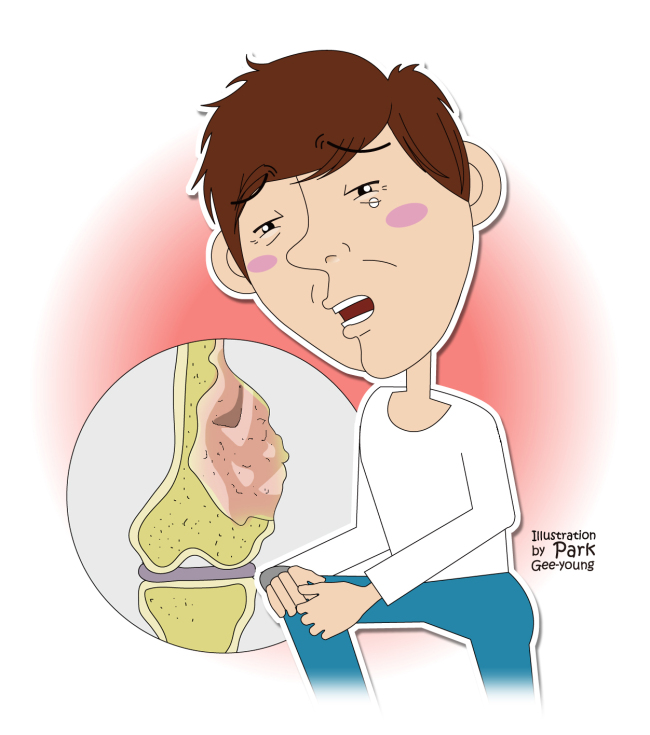 |
Illustration by Park Gee-young |
Sarcoma is a type of cancer that arises from stem cells. It can develop from muscle, fat, nerve, vascular, cartilage or bone tissues.
Sarcomas are broadly classified into soft-tissue sarcomas and osteosarcomas. Soft-tissue sarcomas can arise in any part of the body, but mainly the limbs and retroperitoneum, an area at the back of the abdominal cavity, while osteosarcomas are often found in the limbs.
Soft-tissue sarcomas can be further divided into liposarcomas, rhabdomyosarcomas, neurofibrosarcomas and hemangiosarcomas, according to where they appear. The different treatment options depend on the type of sarcoma.
Soft-tissue sarcomas account for less than 1 percent of all cancers and 50 percent of them arise in an arm or a leg, 15 percent in the retroperitoneum, 15 percent in the rest of the abdomen, 10 percent in the chest and the remaining 10 percent in the head and neck.
Of these sarcomas that develop in the abdomen, gastrointestinal stromal tumor (GIST) is the best known. Other well-known sarcomas include liposarcoma, rhabdomyosarcoma and undifferentiated pleomorphic sarcoma (UPS).
There are no genetic factors known to cause sarcomas and there has not been much research into environmental factors.
However, in patients with GIST, c-KIT, a molecular receptor that exists in the cellular membranes, is often mutated. A medication that targets this receptor, Gleevec, is an effective treatment for them. Although the reasons behind this mutation are yet to be determined, the mutations are thought to be one of the causes of GIST.
Several characteristic mutations have been reported in other sarcomas that arise in the retroperitoneum. For instance, in teh case of liposarcoma, there have been a few mutations (MDM2, CDK4) observed in parts of chromosome 12, which is one of the chromosomes that contain our genes. These mutations are currently used as a useful tool for diagnosis of liposarcoma. However, the pathogenesis, including the cause of the mutations and how they develop cancer, is still under investigation.
There is no gender difference in sarcoma incidence, and it is most commonly found in patients around age 50.
Most sarcomas arising in the retroperitoneum have no specific clinical symptoms, and you may only first notice a slight bulge of the abdomen. These cancers are normally found during a routine checkup. An abdominal ultrasound during a routine checkup may not detect the cancer. Therefore an abdominal CT is advised for early detection of the sarcomas.
In the case of sarcomas found in the retroperitoneum, tumors are often found in an advanced stage due to the absence of clinical symptoms, and tumors larger than 10 centimeters are common. Even though the tumors may be large, metastasis to other parts of the body is rare.
However, liposarcomas and rhabdomyosarcomas can metastasize to the lungs and the liver respectively. Therefore a PET-CT that can detect the presence of metastases is performed before surgery.
Biopsies can be performed prior to surgery for diagnosis of sarcoma. Especially when retroperitoneal lymphoma is suspected, chemotherapy may be required before any surgical approach. A biopsy can give a definite diagnosis.
In the case of GIST, the prognosis is strongly related to its site, size and mitotic activity, so post-op chemotherapy may be necessary depending on these variables.
However, for retroperitoneal sarcomas other than GIST, it is difficult to clearly determine the pathogenesis, unlike in most cancers. In addition, unlike GIST or sarcomas in the limbs, the prognosis of retroperitoneal sarcomas is minimally influenced by the size of the tumor and the shape of the tumor cells. The primary surgical treatment is of utmost importance, as how well and extensively the tumor has been surgically removed plays a very significant role in the prognosis.
A sarcoma arising in the abdomen can have different treatment options due to its location and the surrounding organs. To date, the successful surgical treatment is by far the most important for retroperitoneal sarcomas except GIST (GIST has an effective medication known as Gleevec). In case of liposarcoma especially, the kidney or the parts of the large intestine, which are found in the retroperitoneum, may be invaded by the tumor and the extensive surgical excision of the tumor as well as the surrounding organs may be required in this case.
Adjuvant therapy such as chemotherapy or radiotherapy may be indicated for patients with a specific type of sarcoma or situation post-op. However relapse is common, and additional operation due to relapse is often required.
Patients with liposarcomas are known to respond to radiotherapy post-op, and those with rhabdomyosarcomas often undergo radiotherapy or chemotherapy as an adjuvant therapy.
Since the success of the initial surgery is the most important factor when it comes to the patient’s prognosis, the tumor needs to be extensively removed by an experienced surgeon after which the effective treatment methods are investigated through clinical research on sarcomas.
 |
Kim Sung-joo |
By Kim Sung-joo
The author is a doctor at the Division of Transplant Surgery at Samsung Medical Center and a professor at Sungkyunkwan University School of Medicine. ― Ed.






![[Herald Interview] 'Trump will use tariffs as first line of defense for American manufacturing'](http://res.heraldm.com/phpwas/restmb_idxmake.php?idx=644&simg=/content/image/2024/11/26/20241126050017_0.jpg)


